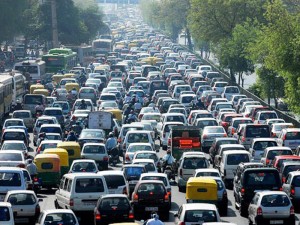I used to live in one of the most dangerous cities for pedestrians: Santo Domingo, Dominican Republic. I remember sitting in a conference where the speaker gave us the most recent statistics in Latin America relating to traffic accidents, deaths, and pedestrian fatalities. It’s certainly not the kind of information you want to hear on an empty stomach, nor the kind that would make momma proud in an email back to home.
Here in Lima, Peru, a city 2.5 times the size of Santo Domingo, I feel like getting through traffic is even more perilous. Not a week, or should I say, a couple of days goes by without a report on a serious accident on a major thoroughfare or highway, and unfortunate cases of pedestrians being involved in traffic accidents. Traffic here feels like it’s a war between the drivers, and then when the pedestrians want to cross, they become the new enemy, because they represent an  impediment to their progress (and maybe a better target because their lack of defense). I understand this frustration, many times I’ve been in a taxi and have had to wait 30-40 minutes to go just a few kilometers.
impediment to their progress (and maybe a better target because their lack of defense). I understand this frustration, many times I’ve been in a taxi and have had to wait 30-40 minutes to go just a few kilometers.
So here’s a statistic that’s not all that comforting from the Inter-American Development Bank from 2012 on road safety :
” . . . more than 100,000 people are killed every year in traffic crashes in Latin America and the Caribbean. Compared with other causes of untimely deaths, road incidents take more lives each day (about 275) than HIV-AIDS does (156). At 17 deaths per 100,000 inhabitants, this region’s roadway fatality rate is nearly double that of higher income countries. (source: http://www.iadb.org/en/news/webstories/2012-08-22/making-road-safety-a-development-priority,10090.html)
I go to eat lunch at a place near my apartment just about everyday called “El Principe.” It sits o Berlin Street, a main corridor for all types of vehicles traveling through the district where I live. There’s stoplight just before this section of Berlin, and all throughout Berlin there are restaurants, bars and two hostels. It can be a traffic nightmare, so vehicles are looking for ways to pass through it as quickly as they can. This usually means breaking the law, and sometimes that means getting caught (maybe “rarely” is a better term than “sometimes”) like the guy driving the Audi R8 that got pulled over right in front of the El Principe. (Lunch at EL Principe will cost you $3.15. Quite a contrast eh?)
This post isn’t about the (awful) state of traffic of Lima, as I could write a couple hundred posts about that, instead it’s about the ability to recognize an opportunity quickly. I have to cross Berlin Street everyday and usually this means that I have a 45 second window from when vehicles start revving down the bowling alley to the unsuspecting pedestrian pins. Everyday on my approach to lunch I have to assess my current walking speed as I near my beloved lunch spot. If I miss the traffic window it means I’ll have to wait a good two minutes and even more tragically, miss an open table at the ever popular El Principe.
“Where am I in the traffic window?” “Did it just begin? Is it ending? Am I going to get my table or be frustrated and hungry on the other side of the street.”
These are the questions I think about, and oddly enough, after almost eight months here, I can make this decision in a split-second. Amazing.
I should focus this ability in other “equally important” areas of my life.
